Too Late to Say Goodbye: A True Story of Murder and Betrayal Read online
ALSO BY ANN RULE
Green River, Running Red
Heart Full of Lies
Every Breath You Take
Bitter Harvest
…And Never Let Her Go
Dead by Sunset
Everything She Ever Wanted
If You Really Loved Me
The Stranger Beside Me
Possession
Small Sacrifices
No Regrets
Worth More Dead
Kiss Me, Kill Me
Without Pity
Last Dance, Last Chance
Empty Promises
A Rage to Kill
The End of the Dream
In the Name of Love
A Fever in the Heart
You Belong to Me
A Rose for Her Grave
The I-5 Killer
The Want-Ad Killer
Lust Killer
FREE PRESS
A Division of Simon & Schuster, Inc.
1230 Avenue of the Americas
New York, NY 10020
The names of some individuals in this book have been changed.
Such names are indicated by an asterisk (*) the first time each appears in the book.
Copyright 2007 by Ann Rule
Photo Credits
Photos: 1, 2, 3, 4, 5, 24, 25, 26, 27, 28, 29, 30, 31, 32, 33, 35, 36, 51, 52, 59 (Barber Family)
Photos: 6, 7, 8 (Shelly Mansfield)
Photos: 9, 10, 11, 13, 14, 15, 18, 19, 20, 58 (Hearn Family)
Photos: 17, 21, 22, 23, 43 (Richmond County Crime Scene Photos)
Photos: 34, 37, 38, 39, 40, 42 (Gwinnett County Police Department
Crime Scene Photos)
Photo 41 (Marcus Head)
Photos: 47 (Chris Thelen), 48, 49, 50 (Annette Drowlette, Augusta Chronicle)
Photos: 53, 55, 56, 57 (Vino Wong, Atlanta Journal Constitution)
Photos: 16, 44, 45, 46, 54, 60, 61 (Ann Rule)
All rights reserved, including the right to reproduce this book or portions thereof in any form whatsoever. For information address Free Press Subsidiary Rights
Department, 1230 Avenue of the Americas, New York, NY 10020
FREE PRESS and colophon are trademarks of Simon & Schuster, Inc.
Visit us on the World Wide Web:
http://www.SimonSays.com
Library of Congress Cataloging-in-Publication Data
Rule, Ann.
Too late to say goodbye: a true story of murder and betrayal / by Ann Rule.—1st Free Press hardcover ed.
p. cm.
1. Corbin, Jennifer, d. 2004. 2. Hearn, Dorothy.
3.Murder—Georgia—Case studies. 4. Murder victims—Georgia—Biography. 5. Murder—Investigation—Georgia. I. Title.
HV6533.G4R86 2007
364.152'3092—dc22 2007009168
ISBN-13: 978-1-4165-5689-3
ISBN-10: 1-4165-5689-3
To All Women Who Are Living in Fear of Recrimination
And Stalking, in a Kind of Captivity, At the Hands of
Men They Once Loved and Trusted
In the Hope
That They Will Find a Safe Way Out
And
To Domestic Violence Groups
Who Are Doing Their
Best to Help
ACKNOWLEDGMENTS
IN ANY NONFICTION BOOK, the input of experts and those who have actually experienced the events therein is essential. This is never more true than in a book about actual criminal cases. The crimes itself, the victim(s), the suspects, the survivors, friends, and the investigators, prosecutors, and judges cannot be fully explored without the contributions of those who were there. When I traveled to Georgia in 2006, I knew only the most basic facts of this true story, and, as always, I worried that I would never discover enough to write the case in the depth I hoped for. Looking back now, I cannot thank the people I met enough for their willingness to show me the multifaceted aspects of two extraordinary investigations into a tragic and convoluted progression of events.
I have always found the residents of Georgia to be gracious and welcoming and my research in Gwinnett County and Richmond County certainly enhanced that impression. Public officials and private individuals in both counties were very open as they allowed me to research vital information, and consented to interviews. They shared their feelings and opinions with me, kept me from getting lost on unfamiliar freeways and country roads, filled me in on Georgia law, and explained the intricacies of advanced forensic science techniques.
Dozens of people who knew and loved Dolly Hearn, Jenn Corbin, and Bart Corbin shared their memories with me, even though they were saddened and shocked by events they could never have foretold.
I’d like to note the following people who were significant in helping me find the truth in Too Late to Say Goodbye:
Max, Narda, and Rajel Barber; Heather and Doug Tierney; Barbara and Dr. Carlton Hearn Sr. and Gil Hearn; Catherine Siewick, and Jane Hearn.
Detective Marcus Head, Sergeant E. T. Edkin of the Gwinnett County Police Department.
Gwinnett County District Attorney Danny Porter and his staff—particularly Chuck Ross, Jack Burnette, Russ Halcome, Mike Pearson, and Jeff Lamphier.
Judge Michael C. Clark and Greg Lundy.
Richmond County District Attorney Danny Craig and his staff: Jason Troiano and Parks White.
Scott Peebles and DeWayne Piper of the Richmond County Sheriff’s Office.
Danny Brown, M.D., of the Georgia Bureau of Investigation.
And, in no particular order, a number of individuals who went out of their way to help me with various aspects of my research: Major Cathie Higgins, Jennifer Rupured, Stacey Ducker, Katherine Sherrington Meyer, Shelly Mansfield, Sheila Hanna, Prioleau Murray, Beverly Knowlton Fournier, Teresa Yawn, Dot Nelems, Darlene Hurst, Julie Hurst, Grace Yrizarry, Randy Ransom, Jennifer Grossman, Renee Walker, Pamela Earley, Loriann Hargis, Dienne Ogletree, Dara Prentice, Bob Reynolds, Sharon Shaw, Nancy J. Fontaine, Beverly Hawkins, Rosemary Heatherly, Ramona Lindsay Cathey, Karen Pirkle, Ilene Nicols, Valynda Vaughn, Pam Prouty, Bill Bufford, Kim Covington, Angie Echols, Maria Bips, Angela Hart, Millie Cartznes, Debbie Whitley, Amanda Jones, Tim Garrett, and Jo Busch, and the hundreds of “ARFs” (Ann Rule Fans) who post on my website’s guestbook at www.annrules.com.
To my fellow journalists: Andria Simmons, The Gwinnett Daily Post, Lateef Mungin, and Anna Varela, The Atlanta Journal Constitution, and Steve Huff at [email protected].
To Drs. Amy Harper, Steven Smith, Kjersten Gmeiner, and Edward Benson of Group Health and their staffs, for their understanding and expertise.
And, finally, in this book that took two-and-a-half years to bring to fruition, I thank the Free Press/Simon & Schuster team that always stands behind me—or pulls me forward: Fred Hills, my editor for eighteen years, whose tenacity helped me weave any loose ends or frustrating details into a book that came in on time, Carolyn Reidy, president of Simon & Schuster, always an inspiration, my encouraging publisher Martha Levin, her assistant, Maria Bruk Auperin, who kept the puzzle pieces where they belonged and never lost her cool, Hilda Koparanian in charge of production, Erich Hobbing the artist responsible for what I think is an outstanding book design and who also is responsible for the photo section, and Carol de Onís and Tom Pitoniak who oversaw the copy editing, detecting all the troublesome spots my own eye missed. I know I’ve said it before, but it’s still true: no author writes a book alone.
To my perennial “first reader,” and gentle critic: Gerry Hay.
And, as always, to the best literary agents an author could hope for, in gratitude
for the many, many years we have been together: Joan and Joe Foley.
CAST OF CHARACTERS
JENNIFER MONIQUE BARBER CORBIN 1971–2004 DR. BARTON THOMAS CORBIN, HER HUSBAND
Dalton and Dillon Corbin, her sons
Max and Narda Barber, her parents
Rajel Barber and Heather Barber Tierney, her sisters
Doug Tierney, her brother-in-law
Eugene and Connie Corbin, Barton’s parents
Bradley Corbin, Barton’s twin brother
Bobby Corbin, Barton’s younger brother
Edwina Tims, Bradley’s wife
Suzanne Corbin, Bobby’s wife
DOROTHY CARLISLE “DOLLY” HEARN 1962–1990
Dr. Carlton Hearn Sr. and Barbara Hearn, her parents
Carlton Hearn Jr. and Gil Hearn, her brothers
AUGUSTA INVESTIGATION, 1990 RICHMOND COUNTY SHERIFF’S OFFICE
Captain Gene Johnson
Lieutenant John Gray
Sergeant Ron Peebles
Sergeant Billy Hambrick
Coroner Leroy Sims
Dr. Sharon Daspit, Medical Examiner
Dr. Farivar Yaghmai, Neuropathologist
Bruce Powers, Chief of Security, Medical College of Georgia
AUGUSTA INVESTIGATION, 2004 RICHMOND COUNTY SHERIFF’S OFFICE
Detective Sergeant Scott Peebles
Crime Scene Investigator DeWayne Piper
Detective Don Bryant
RICHMOND COUNTY DISTRICT ATTORNEY’S OFFICE
Richmond County District Attorney Danny Craig
Deputy District Attorneys: Parks White and Jason Troiano
Dr. Danny Brown, Georgia Bureau of Investigation Medical Examiner
GWINNETT COUNTY INVESTIGATION, 2004 GWINNETT COUNTY POLICE DEPARTMENT
Detective Marcus P. Head
Lieutenant Troy C. Hutson
Sergeant Vic Pesaresi
Sergeant E.T. Edkin
Officer Travis Wright
Officer Michelle Johns
Corporals: Eddie Restrepo, Curtis Clemmons, Fred S. Mathewson, Austin M. Godfrey
Investigators: Michael Marchese, Dave P. Henry, S. Milsap, Chris Penn, Jason Carter, (Norcross Police Department) David Cheek, Gary Linder, C.T. Fish, James R. West, R.C. Nelson, L.B. Davis, G.R. Thompson, Mark A. Lester
Crime Scene Technicians: Amber Roessler, J. Abousselman.
GWINNETT COUNTY DISTRICT ATTORNEY’S OFFICE
District Attorney Danny Porter
Senior Assistant District Attorneys: Tom Davis and Chuck Ross
Chief of District Attorneys Investigators: Jack Burnette
Investigators for the District Attorney: Bob Slezak, Jeff Lamphier, Mike Pearson, Russ Halcome, Kevin Vincent, Manny Perez
Chief Anthony Everage, Troy Police Department, Alabama
J.D. Shelton, Investigator, Alabama Attorney General’s Office
GWINNETT COUNTY MEDICAL EXAMINER’S OFFICE
Carol A. Terry, Medical Examiner
Ray Rawlins, Forensic Investigator
Zubedah Mutawassim, Forensic Technician
SUPERIOR COURT JUDGES
In Richmond County: Judge Carl C. Brown
In Gwinnett County: Judge Michael C. Clark, Judge Melodie Snell Connor, Judge Debra Turner.
DEFENSE ATTORNEYS
David Wolfe, Bruce Harvey, and Steve Roberts
PREFACE
APRIL 24, 2007
WITH EVERY BOOK I write—and this is number 27—I realize more just how many lives are affected when one cruel and conscienceless person decides to take another human being’s life. Murder is not only a matter of a single death; there are many “little deaths” as homicide replicates its evil in countless lives left behind, changing them forever. Even if there are no more homicides committed by a particular killer, I know now that violent death never stops reverberating among those who suffer such terrible loss. The pain resonates like an echo in a series of tunnels—parents lose beloved children, spouses are torn from one another, and children too young to fully grasp the finality of death are destined to mature to a bleak point where they will have to understand what forever means. Families will never again have a complete Christmas or Thanksgiving or reunion; there will always be empty chairs. Friends will grow older and no longer resemble their yearbook pictures—but certain youthful images of lost loved ones will remain engraved on their memories. And even police officers, detectives, prosecutors, defense attorneys, and judges will do what has to be done before moving on to future murders, but all with their lives subtly altered.
Never was this more true than in two complex and drawn-out investigations in the state of Georgia, probes that occurred, technically, in different centuries. Of course, that doesn’t mean they happened many years apart, but simply that the millennium intervened. Even so, one of these tragedies was almost relegated to the past, where it might well have remained were it not for a second shocking event that brought old questions back into the light of day.
And, with the second death, even more sorrow. Could all of this be traced back to one person, a most unlikely suspect, one who may have gone through life totally without conscience, empathy, or remorse?
Perhaps.
OF THE 159 COUNTIES in the state of Georgia, Gwinnett County—northwest of Atlanta—stands out for its amazing exponential growth. In the last two decades, sleepy country towns surrounded by acres of raw land have attracted developers who then created whole neighborhoods with picturesque names drawn from history, nature, or their own imaginations. Houses, apartments, and condos soon burst from the red Georgia clay like the kudzu vine, a slithering, green noxious weed that threatens to creep relentlessly over everything in the state.
For the first few years of development, Gwinnett residents either boasted or complained that theirs was the fastest growing county in America. In the twenty-five years leading up to 2006, the population exploded from 200,000 to almost 800,000. In 1981, the Gwinnett County District Attorney’s Office had six attorneys on staff and a handful of investigators, a number quite adequate to carry out the DA’s business. The current Gwinnett County District Attorney, Danny Porter, was once one of those Assistant DAs. By 2006, after four terms as the District Attorney, Porter had a staff of ninety—including thirty-four lawyers and twenty-three investigators.
By 1990, the historic red-brick courthouse in Lawrenceville was bursting at the seams. The new $72 million Gwinnett County Justice and Administration Center on Langley Road opened in 1991. The modern structure with twenty-two courtrooms featured polished steel banisters, etched-glass walls and dividers, polished parquet floors, and skylights where the drum of a hard rain was almost louder than thunder. It was an expansive complex, yet it too soon began to strain against its walls.
In the District Attorney’s office, a law library had to be sacrificed to make more office space; small cubicles were made even smaller and arranged in what became a challenging maze for the uninitiated.
The visitors’ parking lot was the site of a very large monument dedicated “To America’s Sons and Daughters Who Served Honorably in the Armed Forces.” The sixty-one acres around the justice center were landscaped with chinaberry trees, pin oaks, crepe myrtles, lilies and begonias, azaleas and holly. Both the front and rear entrances were welcoming, but just inside those doors were the guards and metal detectors that have become ubiquitous in courthouses and law enforcement structures across America.
For some who came to this building in Lawrenceville, Georgia, there would be justice and triumph, and for others, heartbreak.
TOO LATE TO SAY GOODBYE
PART ONE
Jennifer Barber Corbin
“JENN”
CHAPTER ONE
DECEMBER 4, 2004
THE SHRIEK OF SIRENS piercing the chill December morning on Bogan Gates Drive was almost as alien as the thackety-thackety of helicopters overhead would be. This quiet street in Buford is a relatively new part of an upscale neighborhood, home to young and middle-aged pr
ofessionals and their families. The houses here have mostly red-brick façades with glossy black shutters, not unlike homes in Atlanta’s more affluent districts, but on a smaller scale. In 2004, the average price of a home in Bogan Gates was between $200,000 and $300,000—the homes would cost twice that in Denver or Seattle or Philadelphia. Buford is an ideal suburb for those who commute the thirty-five miles to Atlanta: large enough with over 14,000 residents to merit local shopping centers, but small enough to dissolve the tension that comes with driving the I-285 beltway that encircles Atlanta with bumper-to-bumper traffic. And Bogan Gates Drive itself is an oasis of serenity with its manicured lawns and colorful gardens. Children play under the watchful eyes of all the adults there. If some stranger should insinuate himself into this enclave, he would not go unnoticed.
A negative note, at least for some, is that close neighbors tend to know each other’s secrets. There isn’t the anonymity that exists in apartment buildings in large cities. Neither is there the loneliness that city dwellers sometimes feel. Even so, some families on the street have secrets that none of their neighbors could possibly imagine.
That doesn’t stamp Bogan Gates as different; every community has its mysteries and even its surprising secrets. When reporters for television news and local papers sweep into such places, they are certain to obtain instant interviews with shocked residents who invariably say: “Something like that just doesn’t happen here—not in our neighborhood!”
But, of course, it does.
On this day in early December, Bogan Gates Drive just happened to be the site of one of the most horrific crimes in Georgia.
The town of Buford, its name as Southern as a name can be, sits close to Lake Lanier. This popular vacation spot’s waters meander for mile after mile, cutting channels deep and wide into the shoreline, leaving inlets that resemble the bite marks of a giant alligator. Buford is surrounded by other small townships: Flowery Branch, Sugar Hill, Suwanee, Duluth, Oakville, Alpharetta. It is very close to the border between Gwinnett and Forsyth counties. Forsyth County once had a reputation as one of the most racially prejudiced areas in America. A sign beside the road there could read “Boiled Peanuts,” or it might say, “Nigger, Get Out of Forsyth County, Before Sunset.” But no longer. Oprah Winfrey once broadcast her show from Forsyth County, pulling aside the blinds to reveal raw prejudice. Today, those with set ideas about racial disparities have learned not to voice them aloud.

 Too Late to Say Goodbye: A True Story of Murder and Betrayal
Too Late to Say Goodbye: A True Story of Murder and Betrayal Green River, Running Red
Green River, Running Red Bitter Harvest
Bitter Harvest Dead by Sunset: Perfect Husband, Perfect Killer?
Dead by Sunset: Perfect Husband, Perfect Killer? Lust Killer
Lust Killer And Never Let Her Go: Thomas Capano: The Deadly Seducer
And Never Let Her Go: Thomas Capano: The Deadly Seducer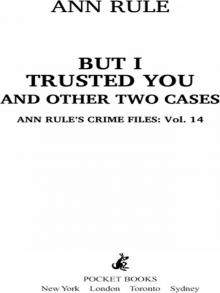 But I Trusted You and Other True Cases
But I Trusted You and Other True Cases Smoke, Mirrors, and Murder and Other True Cases
Smoke, Mirrors, and Murder and Other True Cases If You Really Loved Me
If You Really Loved Me Kiss Me, Kill Me and Other True Cases
Kiss Me, Kill Me and Other True Cases Fatal Friends, Deadly Neighbors and Other True Cases
Fatal Friends, Deadly Neighbors and Other True Cases Practice to Deceive
Practice to Deceive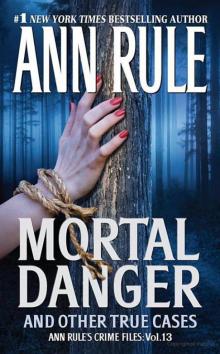 Mortal Danger and Other True Cases
Mortal Danger and Other True Cases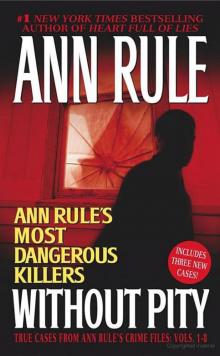 Without Pity: Ann Rule's Most Dangerous Killers
Without Pity: Ann Rule's Most Dangerous Killers Everything She Ever Wanted
Everything She Ever Wanted A Fever in the Heart and Other True Cases
A Fever in the Heart and Other True Cases In the Still of the Night
In the Still of the Night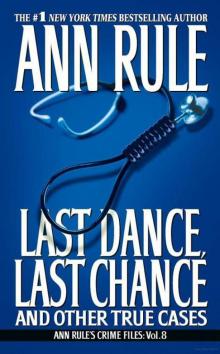 LAST DANCE, LAST CHANCE - and Other True Cases
LAST DANCE, LAST CHANCE - and Other True Cases A Rage to Kill
A Rage to Kill The I-5 Killer
The I-5 Killer The Stranger Beside Me
The Stranger Beside Me Everything She Ever Wanted: A True Story of Obsessive Love, Murder, and Betrayal
Everything She Ever Wanted: A True Story of Obsessive Love, Murder, and Betrayal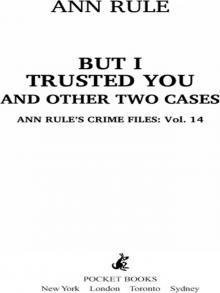 But I Trusted You
But I Trusted You Without Pity
Without Pity Kiss Me, Kill Me
Kiss Me, Kill Me Too Late to Say Goodbye
Too Late to Say Goodbye Lying in Wait
Lying in Wait Fatal Friends, Deadly Neighbors
Fatal Friends, Deadly Neighbors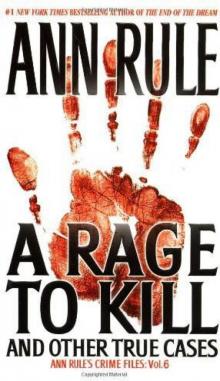 A Rage to Kill: And Other True Cases
A Rage to Kill: And Other True Cases And Never Let Her Go
And Never Let Her Go Lying in Wait Ann Rule's Crime Files Vol.17
Lying in Wait Ann Rule's Crime Files Vol.17 Blood Secrets: Chronicles of a Crime Scene Reconstructionist
Blood Secrets: Chronicles of a Crime Scene Reconstructionist No Regrets
No Regrets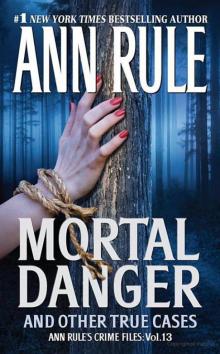 Mortal Danger
Mortal Danger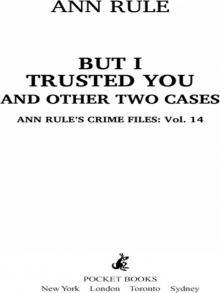 But I Trusted You: Ann Rule's Crime Files #14
But I Trusted You: Ann Rule's Crime Files #14 Empty Promises
Empty Promises Dead by Sunset
Dead by Sunset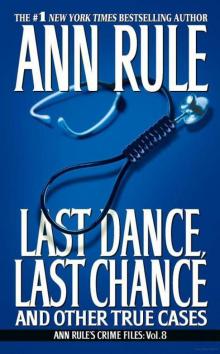 Last Dance, Last Chance
Last Dance, Last Chance Don't Look Behind You
Don't Look Behind You